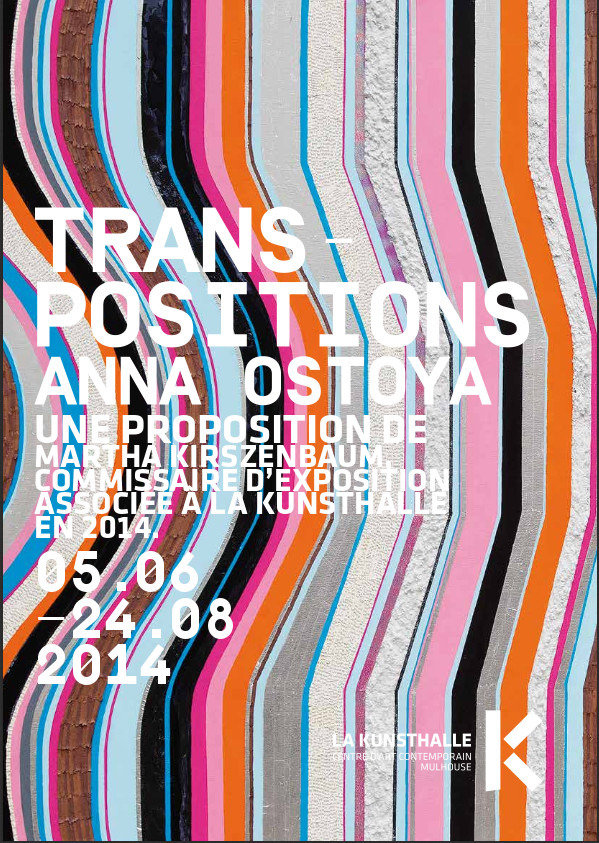Anna Ostoya
dal 3/6/2014 al 23/8/2014
Segnalato da
3/6/2014
Anna Ostoya
Kunsthalle Mulhouse Centre d'art contemporain, Mulhouse
Transpositions. The show comprises 10 large, horizontal new compositions, in which Ostoya sets into motion a leitmotif: a square is transposed from one canvas to the next in a sequence.

In a conceptual practice that incorporates collage, photomontage, painting,
sculpture, and writing, Anna Ostoya has developed a singular and critical
body of works that concentrates on avant-garde aesthetics, particularly on the
representation of feminism, the tension between image and media, and the legacy
of 20th century art movements including Constructivism, Dada, Art Informel,
Expressionism, and Minimalism. Recycling pre-existing images, materials and
histories, Ostoya challenges notions of deconstruction and authenticity. Her work
forms a continuity out of fragments as a process of creating new meanings and as
a vehicle for political change. Using materials that range from the precious (gold
leaf) to the mundane (newspaper) and from the industrial (aluminum leaf) to the
organic (blood), Ostoya calls into question the very conventions she appropriates.
Transpositions
is the first institutional exhibition of the artist in France and the
title of a new series of works conceived for La Kunsthalle Mulhouse. Over a period
of eight months, Ostoya followed a work plan and set up rules to experiment with
different modes of decision-making. The history and architecture of La Kunsthalle’s
building itself, a former industrial factory functioning as a foundry from the early
1920s through the 1980s, directly inspired the production of the pieces. The series
is derived from considerations regarding past and present work practices and
procedures. In her working process for
Transpositions
, as for some of her previous
series, Ostoya reflects on the role and position of an artist in society: she disputes
the stereotypes applied to an artist—that of a free spirit, an entrepreneur, or a
worker. Testing the possibilities for artistic production, she juxtaposes the notion
of art as an emotional, spontaneous, and disinterested expression with the notion
of art as a rational, controlled, and purposeful endeavor.
Transpositions
comprises ten large, horizontal new compositions, each spanning
100 by 200 cm, in which Ostoya sets into motion a leitmotif: a square is transposed
from one canvas to the next in a sequence of ten. The square—a shape prized
for the purity of its form by the Suprematists and other modernists—evolves as
it slides from one work to the next as if on an assembly line. Recycling leftover
materials from earlier works and reclaiming distinct art-historical traditions,
these compositions are retrospective investigations of historical permanence
and transition, continuity and rupture. Transposition—the act of transferring
something from one place or context to another and a term used in various pursuits,
including music, law, mathematics, genetics, and chess—implies both Ostoya’s
methodology and the literal movement of the square across the canvases, but it
also alludes to the generational and cultural transference of ideas and forms. The
heterogeneous materials and techniques used by Ostoya range from oil paint to
acrylic or shellac, from palladium leaf to paper or fabric, which she cuts, pastes,
apposes, and transposes.
The exhibition is accompanied by the first monograph of Ostoya’s work that
considers her oeuvre as a whole. The works reproduced in the book are the
outcome of years of artistic practice and vivid discussions with curators, writers,
and thinkers, such as the authors of this volume, Ben Lerner and Tom Williams.
Writer Ben Lerner evocatively recounts his encounters with three of Ostoya’s works,
discovering how the borders between images and shapes in them become rich
sites of historical reflection and critique; art historian Tom Williams contemplates
Ostoya’s oeuvre through the prism of avant-garde critique, focusing on her varied
appropriations of art-historical styles and imagery.
Martha Kirszenbaum
Anna Ostoya
(born 1978 in Krakow, Poland, lives and
works in Brooklyn, USA) studied at the Parsons School of
Art and Design in Paris and at Städelschule in Frankfurt
am Main. From 2008 to 2009, she participated in the
Whitney Independent Study Program in New York City.
Her photomontages and collages were recently included
in “New Photography 2013” at the Museum of Modern
Art, New York. In 2012, she was commissioned to present
a project as part of “Thing/Thought: Fluxus Editions, 1962-
1978” at the Museum of Modern Art, New York. Her work
has been exhibited at the Second Athens Biennial (2009)
and Manifesta 7, Rovereto, Italy (2008). Ostoya’s major
solo presentations include Bortolami Gallery, New York
(2011 and 2013); Silberkuppe, Berlin (2011 and 2013);
Tegenboschvanvreden, Amsterdam (2011); Foksal Gallery,
Warsaw (2010); and Kronika Center for Contemporary Art,
Bytom (2010). Group exhibitions include the Gesellschaft
für Aktuelle Kunst, Bremen (2013), L’Espace de L’Art
Concret, Mouans-Sartoux (2012), The Power Plant,
Toronto (2011); Center for Curatorial Studies Bard College,
Annandale-on-Hudson (2010); Lisson Gallery, London
(2009); and Zachęta National Gallery of Art, Warsaw
(2007)
Martha Kirszenbaum
(born 1983) is a curator and writer
based in Los Angeles and Paris. She has worked in the
Department of Media and Performance Art at the Museum
of Modern Art, New York; in the Cabinet of Photography
at Centre Georges Pompidou; and at the New Museum,
New York. She was the curator-in-residence at the Center
for Contemporary Art, Warsaw, and at the Belvedere
Museum/21er Haus, Vienna. She presently serves as the
director and curator of Fahrenheit, a new exhibition space
and residency program in Los Angeles.
Press contact
Clarisse Schwarb Tel: 03 69 776628 Email: clarisse.schwarb@mulhouse.fr
Vernissage wednesday 4 june, 6.30pm
La Kunsthalle Mulhouse Centre d’art contemporain
La Fonderie 16 rue de la Fonderie 68093 Mulhouse Cedex
Hours:
Wednesday to Friday, noon to 6 pm; Saturday
and Sunday, 2 pm to 6 pm; late-night opening
Thursdays until 8 pm
Closed Mondays, Tuesdays and April 18 & 20; May 1 & 8th
Free admission



